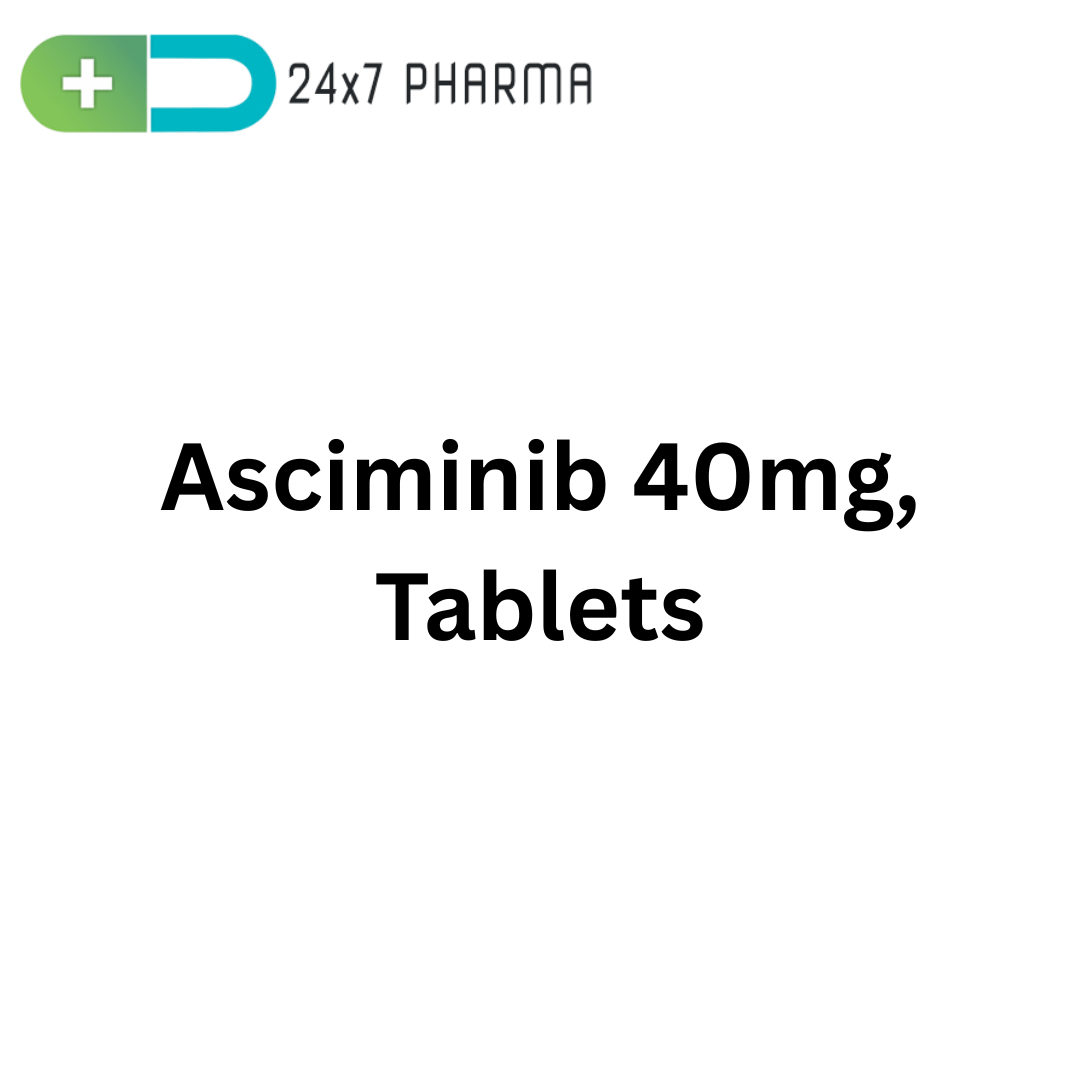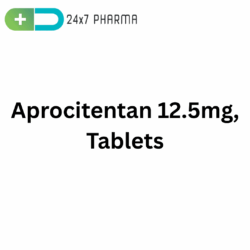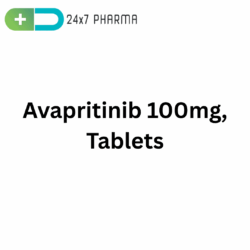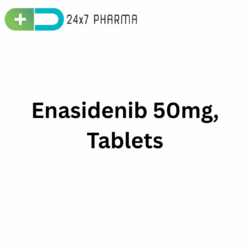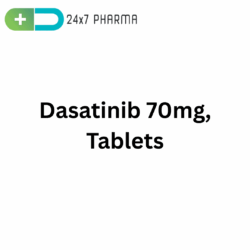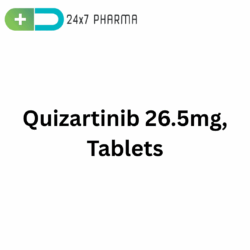LuciAsc 40mg, Asciminib Tablets
LuciAsc, containing the active ingredient asciminib, is a targeted therapy approved for the treatment of Philadelphia chromosome-positive chronic myeloid leukemia (Ph+ CML) in chronic phase.
It is particularly beneficial for patients who have been previously treated with two or more tyrosine kinase inhibitors (TKIs) or those with the T315I mutation, a common mutation that confers resistance to many standard TKIs.
Patients who become resistant or intolerant to conventional TKI medications have a new therapy option with asciminib. This new drug’s application status, patient reviews, and efficacy of treatment could garner a lot of media attention.
When new medications like Asciminib are approved, pertinent clinical practice standards and medical guidelines may also be revised. These improvements will help physicians utilize these medications more sensibly and improve patient outcomes.
What is Asciminib?
Asciminib works by selectively inhibiting the BCR-ABL1 protein through a novel mechanism, making it effective in patients who are resistant to other treatments.
This unique mechanism allows asciminib to inhibit the BCR::ABL1 fusion protein effectively, even in the presence of mutations like T315I that typically confer resistance to other TKIs.
Asciminib is a synthetic oral medication that selectively inhibits the ABL1 kinase, a protein linked to the abnormal proliferation of white blood cells in Ph+ CML. Unlike traditional TKIs, asciminib binds to a unique site on the ABL1 protein, known as the myristoyl pocket, preventing its activation and subsequent leukemogenesis.
Mechanism of Action
In CML, the BCR::ABL1 fusion protein lacks this myristoylated N-terminal, leading to constitutive kinase activity. By binding to the myristoyl pocket, asciminib stabilizes the kinase in an inactive conformation, thereby inhibiting its oncogenic activity.
LuciAsc (asciminib) is a STAMP inhibitor — it Specifically Targets the ABL Myristoyl Pocket on the BCR-ABL1 fusion protein, which causes chronic myeloid leukemia (CML).
Unlike traditional tyrosine kinase inhibitors (TKIs) that block the ATP-binding site, asciminib binds to the myristoyl pocket of the ABL1 kinase domain. This binding restores the natural auto-inhibition of the ABL1 protein, effectively shutting down the abnormal signaling that drives CML.
This unique mechanism:
- Avoids cross-resistance with ATP-competitive TKIs.
- Is effective against some resistant mutations, including T315I (a common cause of TKI resistance).
In summary, asciminib offers a new and targeted way to inhibit BCR-ABL1 activity in patients who have limited options due to TKI resistance or intolerance.
Asciminib Indications
Adult patients with the following conditions can benefit from asciminib treatment:
- Ph+ CML in chronic phase (CP) is Philadelphia chromosome-positive chronic myeloid leukemia that has received two or more tyrosine kinase inhibitors (TKIs) in the past.
- Major molecular response (MMR)-based expedited approval has been granted for this indication. Before this indication may remain approved, a confirmatory study or trials may be necessary to validate and characterize the therapeutic benefit.
Its use is targeted toward specific patient populations who have limited options due to resistance or intolerance to previous treatments.
Dosage and Administration
Novartis was the original developer of asciminib, which is available in two dosages (20 mg and 40 mg) to accommodate various patient demands.
Asciminib is administered orally, with the following dosing regimens:
- Always refer to a physician or product label for tailored dosing.
- For patients previously treated with two or more TKIs: 40 mg twice daily (approximately 12-hour intervals) or 80 mg once daily.
Storage – LuciAsc 40 mg (Asciminib)
- Allowable range: 15°C to 30°C (59°F to 86°F)
- Do not use after the expiration date
- Keep out of reach of children
- No refrigeration required. Store in a dry, cool place.
Side Effects
Common side effects of asciminib include:
- Hematologic: Decreased hemoglobin, neutrophils, and platelets.
- Gastrointestinal: Diarrhea, nausea.
- Metabolic: Elevated uric acid, cholesterol, triglycerides, amylase, and serum lipase.
- Cardiovascular: Hypertension, increased serum creatine kinase.
- Dermatologic: Skin rash.
- Endocrine: Decreased serum calcium and phosphate.
- Hepatic: Increased liver enzymes (ALT, AST, bilirubin).
Serious side effects may include:
- Pancreatitis
- High blood pressure
- Cardiac issues (e.g., QT prolongation)
- Severe myelosuppression
Prescription
LuciAsc is a prescription medication and should be used under the supervision of a healthcare provider experienced in the management of CML.
Drug Interactions – LuciAsc 40 mg (Asciminib)
- CYP3A4 inhibitors (e.g., ketoconazole, clarithromycin):
May increase asciminib levels, raising risk of side effects. Dose adjustment may be needed. - CYP3A4 inducers (e.g., rifampin, carbamazepine):
May decrease asciminib effectiveness by lowering its blood levels. - Medications that lengthen the QT interval, such as antipsychotics and several antiarrhythmics:
Because asciminib can also alter heart rhythm, use it with caution. - P-glycoprotein (P-gp) substrates:
Possible interactions; monitor closely.
Always inform your doctor about all medications, supplements, or herbal products you’re taking before starting LuciAsc.
FAQs
How does LuciAsc work?
A: LuciAsc targets a unique site on the BCR-ABL1 protein called the myristoyl pocket, blocking leukemia cell growth in a way different from other TKIs.
What side effects should I watch for?
A: Common ones include fatigue, nausea, headache, and increased liver or pancreatic enzymes. Contact your doctor if you experience severe symptoms like abdominal pain or irregular heartbeat.
Do I need regular monitoring?
A: Yes, your doctor will monitor blood counts, liver and pancreatic enzymes, and heart function during treatment.
Can asciminib be take with food?
A: No, asciminib should be taken on an empty stomach, at least 2 hours after eating and 1 hour before eating again.
Conclusion
Asciminib (LuciAsc 40 mg) represents a significant advancement in the treatment of Philadelphia chromosome-positive chronic myeloid leukemia, particularly for patients who have developed resistance to other tyrosine kinase inhibitors.
Its unique mechanism of action and targeted inhibition of the ABL1 kinase domain, including the T315I mutation, offer new hope for patients with limited treatment options. While generally well-tolerated, regular monitoring for potential side effects and drug interactions is essential to ensure optimal therapeutic outcomes.

